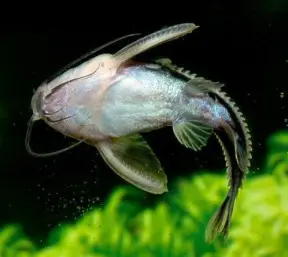Platydoras armatulus
Humbug Catfish
Classification
Doradidae
Distribution
Has a huge natural range encompassing the Rio Orinoco basin in Colombia and Venezuela, the Rio Essequibo in Guyana, coastal drainages of Suriname and French Guiana, parts of the Amazon basin in Peru, Bolivia and Brazil and the Rio Tocantins and Rio ParnaÃba basins also in Brazil.
Habitat
Slow-moving and standing waters including tributaries, creeks and swamps. It’s usually found sheltering among roots or submerged vegetation.
Maximum Standard Length
9.6″ (24cm). Captive specimens of this size are rare, but it’s easily capable of reaching 6″ (15cm).
Aquarium SizeTop ↑
It’s not very active but due to its potential size will still need a tank measuring at least 48″ x 12″ x 12″ (120cm x 30cm x 30cm) – 108 litres.
Maintenance
It’s a shy, nocturnal species so it’s best to keep the tank dimly lit. Provide plenty of hiding places in the form of clay flowerpots, lengths of plastic piping, tangles of driftwood etc. Plants aren’t essential but are useful in cutting out the amount of light hitting the bottom of the tank and providing extra cover.
If you buy one of these for your community tank you’ll probably find it will head straight for an area of cover and remain there during the hours of daylight. If you want to see it more often, consider installing a red light above the tank. It can’t see red lightwaves, so if you switch this on at night you should be able to observe it foraging for food. It usually becomes much bolder as it grows, and adult specimens will often cruise the tank whether the lights are on or not.
Water Conditions
Temperature: 76 to 86°F (24 to 30°C)
pH: 5.8 to 7.5
Hardness: 2 to 20°H
Diet
Omnivorous and easy to feed. Use a good quality sinking pellet or tablet as the staple diet. Supplement this with live and frozen foods such as bloodworm, small earthworms and similar. It’s best to add food after lights out to ensure it gets its share.
Behaviour and CompatibilityTop ↑
Totally unaggressive but it will eat smaller fish so isn’t really suitable for the general community. It can be kept with most peaceable species that are too big too be considered food, including medium-sized characins, cyprinids, anabantoids, livebearers, cichlids and other non-territorial catfish.
It’s tolerant of conspecifics and a group can usually be kept without any problems. If several are present they’ll often share the same refuge during the day. While some jostling for position might occur, no physical damage is usually done.
Sexual Dimorphism
Unknown.
Reproduction
There are no reports of breeding in the hobby. Apparently in nature it spawns amongst surface vegetation.
NotesTop ↑
This popular species is also sold as the striped dora, striped raphael or striped talking catfish. It’s often seen as an ideal beginner’s cat, being hardy and tolerant of a wide range of water conditions. However its secretive nature, adult size and tendency to snack on smaller tankmates mean it should only be considered for communities of larger fish.
The ‘talking catfish’ moniker is derived from the fish’s ability to produce sounds when communicating with conspecifics or when threatened. It can produce these sounds in two ways. The first involves partially locking the pectoral fins into their sockets. The fish can then grind the spines on the pectorals against the socket, producing a ‘buzzing’ sound. The second is by rapidly contracting and relaxing a muscle that is attached to the back of the skull at one end and the front of the swim bladder at the other. This causes the swimbladder to resonate and produces a slightly deeper sound. The noises are clearly audible and can sometimes be heard through the aquarium glass, or when the fish is netted. Do take care when netting these cats, as the spines on the body and fins can easily become entangled in the mesh of aquarium nets. The sharp pectoral spines can also cause an eye-watering wound if you happen to be impaled by them.
Interestingly juveniles of this species have been observed to participate in the “cleaning” of larger fish, specifically a species of wolf fish Hoplias cf. malabaricus. These normally highly piscicvorous Characins allow the catfish to roam over their bodies picking off parasites and dead scales in a behaviour reminiscent of some well-known marine species.




November 22nd, 2018 at 9:37 am
Hello !
Thank you for all the work you make !
Just a little mistake here, you forgot to change the text below the images, this fish are not more Platydoras costatus.
Apologizes about my english 😀
Bye!